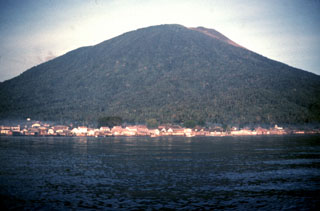Report on Gamalama (Indonesia) — 14 December-20 December 2011
Smithsonian Institution / US Geological Survey
Weekly Volcanic Activity Report, 14 December-20 December 2011
Managing Editor: Sally Sennert.
Please cite this report as:
Global Volcanism Program, 2011. Report on Gamalama (Indonesia) (Sennert, S, ed.). Weekly Volcanic Activity Report, 14 December-20 December 2011. Smithsonian Institution and US Geological Survey.
Gamalama
Indonesia
0.81°N, 127.3322°E; summit elev. 1714 m
All times are local (unless otherwise noted)
Based on a SIGMET and information from the Ujung Pandang City MWO, the Darwin VAAC reported that on 14 December an ash plume from Gamalama rose to an altitude of 3 km (10,000 ft) a.s.l. and drifted 140 km S.
Geological Summary. Gamalama is a near-conical stratovolcano that comprises the entire island of Ternate off the western coast of Halmahera, and is one of Indonesia's most active volcanoes. The island was a major regional center in the Portuguese and Dutch spice trade for several centuries, which contributed to the extensive documentation of activity. Three cones, progressively younger to the north, form the summit. Several maars and vents define a rift zone, parallel to the Halmahera island arc, that cuts the volcano; the S-flank Ngade maar formed after about 14,500–13,000 cal. BP (Faral et al., 2022). Eruptions, recorded frequently since the 16th century, typically originated from the summit craters, although flank eruptions have occurred in 1763, 1770, 1775, and 1962-63.

